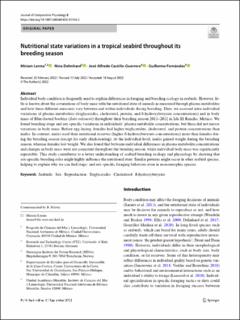| dc.contributor.author | Lerma, Miriam | |
| dc.contributor.author | Dehnhard, Nina | |
| dc.contributor.author | Castillo‑Guerrero, José Alfredo | |
| dc.contributor.author | Fernández, Guillermo | |
| dc.coverage.spatial | Isla El Rancho, Mexico | en_US |
| dc.date.accessioned | 2022-09-21T06:44:28Z | |
| dc.date.available | 2022-09-21T06:44:28Z | |
| dc.date.created | 2022-09-15T15:35:31Z | |
| dc.date.issued | 2022 | |
| dc.identifier.issn | 0174-1578 | |
| dc.identifier.uri | https://hdl.handle.net/11250/3020041 | |
| dc.description.abstract | Individual body condition is frequently used to explain differences in foraging and breeding ecology in seabirds. However, little is known about the covariations of body mass with the nutritional state of animals as measured through plasma metabolites and how these different measures vary between and within individuals during breeding. Here, we assessed intra-individual variations of plasma metabolites (triglycerides, cholesterol, protein, and ß-hydroxybutyrate concentrations) and in body mass of Blue-footed boobies (Sula nebouxii) throughout their breeding season 2011–2012 in Isla El Rancho, Mexico. We found breeding-stage and sex-specific variations in individuals’ plasma metabolite concentrations, but these did not mirror variations in body mass. Before egg-laying, females had higher triglycerides, cholesterol, and protein concentrations than males. In contrast, males used their nutritional reserves (higher ß-hydroxybutyrate concentrations) more than females during the breeding season (except for early chick-rearing). At the individual level, males gained weight during the breeding season, whereas females lost weight. We also found that between-individual differences in plasma metabolite concentrations and changes in body mass were not consistent throughout the breeding season, while individual body mass was significantly repeatable. This study contributes to a better understanding of seabird breeding ecology and physiology by showing that sex-specific breeding roles might highly influence the nutritional state. Similar patterns might occur in other seabird species, helping to explain why we can find stage- and sex-specific foraging behaviors even in monomorphic species. Seabirds, sex, reproduction, triglycerides, cholesterol, ß-hydroxybutyrate | en_US |
| dc.language.iso | eng | en_US |
| dc.rights | Navngivelse 4.0 Internasjonal | * |
| dc.rights.uri | http://creativecommons.org/licenses/by/4.0/deed.no | * |
| dc.subject | Seabirds | en_US |
| dc.subject | sex | en_US |
| dc.subject | reproduction | en_US |
| dc.subject | triglycerides | en_US |
| dc.subject | cholesterol | en_US |
| dc.subject | ß-hydroxybutyrate | en_US |
| dc.title | Nutritional state variations in a tropical seabird throughout its breeding season | en_US |
| dc.title.alternative | Nutritional state variations in a tropical seabird throughout its breeding season | en_US |
| dc.type | Peer reviewed | en_US |
| dc.type | Journal article | en_US |
| dc.description.version | publishedVersion | en_US |
| dc.rights.holder | © 2022 The Authors | en_US |
| dc.subject.nsi | VDP::Zoologiske og botaniske fag: 480 | en_US |
| dc.subject.nsi | VDP::Zoology and botany: 480 | en_US |
| dc.source.journal | Journal of Comparative Physiology. B, Biochemical, Systemic, and Environmental Physiology | en_US |
| dc.identifier.doi | 10.1007/s00360-022-01456-3 | |
| dc.identifier.cristin | 2052171 | |
| dc.relation.project | Andre: Fondo Mexicano para la Conservación de la Naturaleza A.C. | en_US |
| dc.relation.project | Andre: d Instituto de Ciencias del Mar y Limnología- UNAM | en_US |
| dc.relation.project | Andre: Consejo Nacional de Ciencia y Tecnologia (CONACyT) | en_US |
| cristin.ispublished | true | |
| cristin.fulltext | original | |
| cristin.qualitycode | 1 | |

